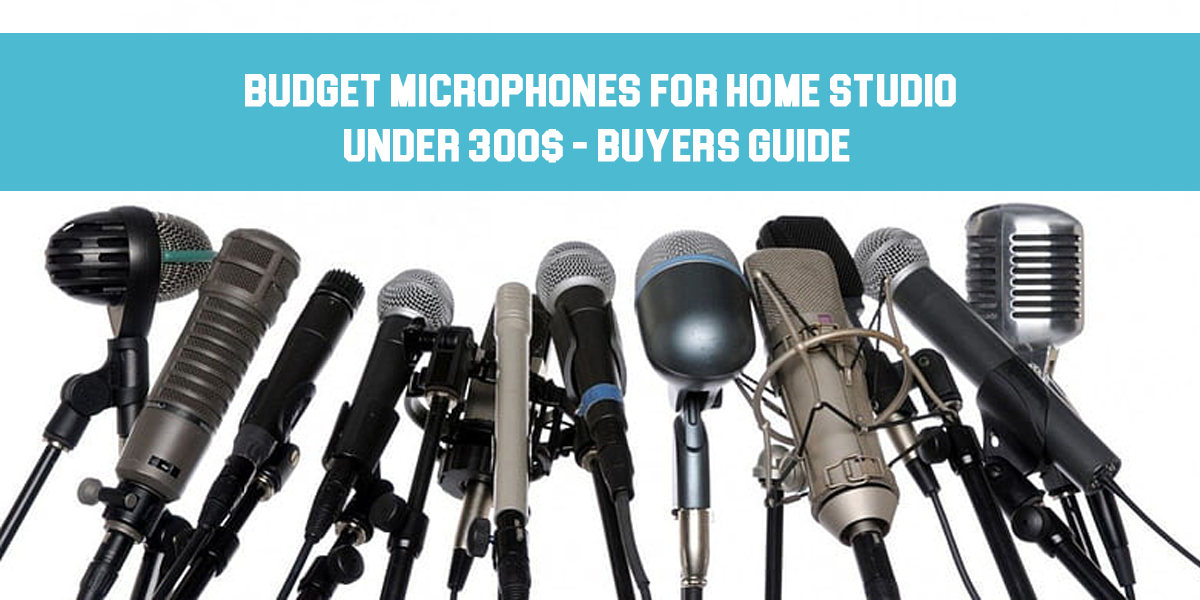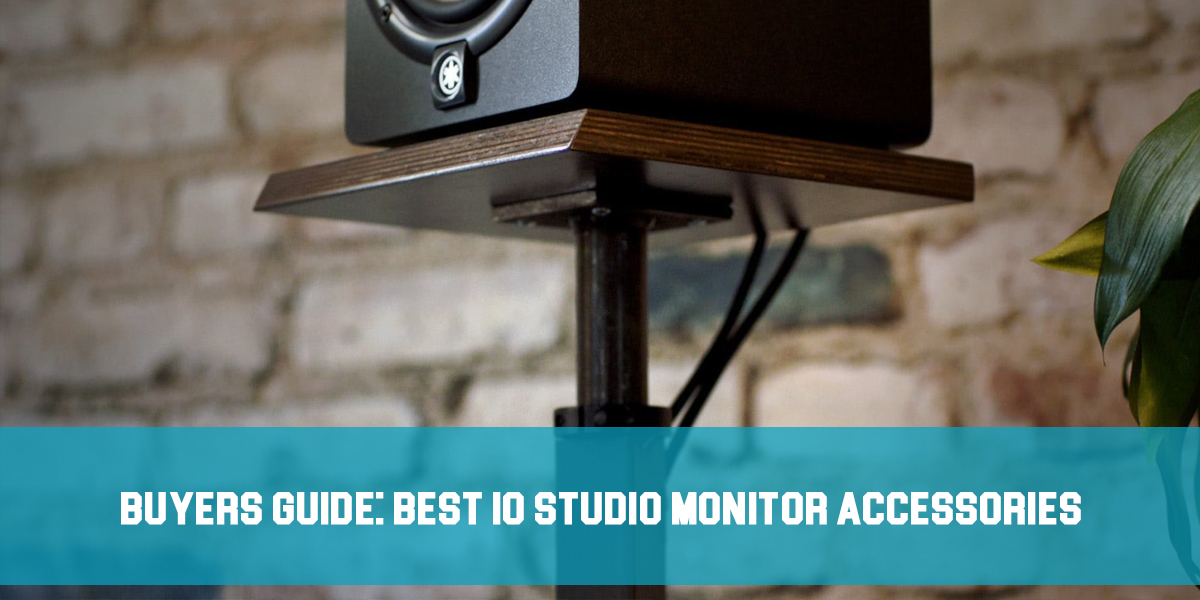Top 10 500 Series Chassis
Introduction
With the growing popularity of 500 series gear, more and more companies are now making their own versions of 500 series racks.
As these companies compete for market share, we’re seeing a wide variety of cases, each with its own pros and cons. Some offer features like link switches, stereo compatibility, and extra routing options—perfect for producers who want to get really modular with their summing and routing.
We’re truly spoiled for choice now, which can make it a bit confusing to know where to start when choosing the right 500 series chassis for your studio.
History of 500 Series Modules
The 500‑series format was created by API founder Saul Walker in 1968, shaping the design of his consoles. The earliest standalone racks were probably DIY projects, but in 1978, Datatronix—who produced API products during a period when API had stopped manufacturing—introduced a 10‑slot rack.
Aphex also adapted a rack originally meant for their own modules so it could hold API ones as well. The 500 series was not the only modular system at the time, and it stayed a niche offering until the 1980s. That’s when the idea of a “lunchbox”—a portable, modular recording channel made up of 500‑series modules—caught on with freelance engineers working in different studios. Interestingly, it was an Aphex rack that was first called a lunchbox. Since 1985, API has been making two, six, and 10‑slot 500‑series chassis and owns the Lunchbox trademark.
What are 500 Series Modules?
The term ‘lunchbox’ gets thrown around a lot in the industry, often leaving people confused. For those in the know, it’s clear that this isn’t about a box for your sandwiches—instead, it’s a game-changer for how the audio world interacts with rack unit gear. Believe it or not, the lunchbox has become a hugely popular modular analog format for rack equipment.
At its core, individual modules (like an EQ) are slotted into a rack that supplies power to each module. Each case is designed to hold multiple modules, and in addition to powering them, the case also handles the input and output routing for every unit. These 500 series modules are housed in a chassis, so let’s take a closer look at exactly what that means.
500 Series Enclosure Fundamentals
500 series modules are housed in a powered enclosure, commonly called a chassis, rack, or lunchbox.
Chassis and racks are made to be rack-mounted, while a lunchbox is designed to be portable (its shape and carrying handle are reminiscent of an actual lunchbox).
The enclosure serves several purposes:
- It supplies power to all modules, including 48V phantom power.
- It provides connectivity for all modules via XLR, ¼”, and/or DB-25 inputs and outputs.
- It offers safe housing to protect modules from damage.
- Some enclosures also offer features like stereo linking or audio summing.
- What to Look For in a 500 Series Enclosure
Here are the most important things to consider when choosing an enclosure:
- Compatibility
- Plenty of connectivity options
- Enough power for all your modules
- Compatibility with older 500 series modules
Just a heads up: we’ll list these 500 Series chassis in no particular order. They’ll be randomized, since we don’t want to sort them from best to worst.
Listed below are our Top 10 Best 500 Series Chassis:
1. Rupert Neve Designs R6
With considerable power and versatile connections, the R6 delivers peace of mind for engineers who demand the highest level of confidence in their 500 series racks.
When it comes to power, the R6 offers more than twice the required current for a 6-space chassis, ensuring the power rails won’t fail under heavier-than-expected loads. To help with monitoring and troubleshooting problematic modules, the R6 is equipped with LED current meters that clearly show how much energy is being used.
The internal power supply has been carefully engineered and double-shielded to prevent any unwanted magnetic induction in any of the channel positions. With such attention to delivering and monitoring power, the R6 allows your modules to perform at their best.
With a wide range of connections available, the R6’s back panel is almost a patch bay on its own. The R6 features 8 channels of balanced I/O options including DB-25, XLR, and TRS, which can be used interchangeably. This flexibility is especially handy when you bring the R6 to a new environment and are unsure what cables are available, or if you need to convert between DB-25, XLR, or TRS using the THRU function on channels 7-8.
The chassis is made of sturdy metal with bumpers to support the unit in both horizontal and vertical positions, and it features a collapsible handle for easy transport. All connectors and fittings are of the highest quality, ensuring the R6 will stand up to years of use.
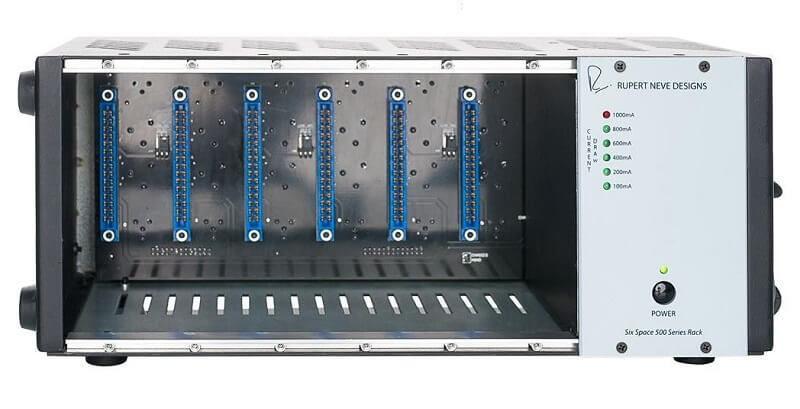
- 3 Link jumpers can be set to allow linking on channels 1-2, 3-4 and 5-6
- Solid steel chassis
- Dimensions (L x W x H): 330 x 190 x 139 mm
- Weight: 4.31 kg
| For US Customers | For EU Customers | |||
|---|---|---|---|---|
Rupert Neve Designs R6 |
2. Cranborne Audio 500R8
The 500R8 is impressively versatile—it serves as a USB audio interface, monitor controller, 500 Series rack, and summing amplifier. Unlike many devices that try to do it all and fall short, the 500R8 excels in every role. Despite offering such a wide range of features, it remains surprisingly user-friendly and intuitive. Plus, it’s priced reasonably.
This 4RU unit is built into a sturdy metal chassis and comes with detachable rack ears, which can be converted into a carrying handle for extra convenience.
Most of the front panel is left open so you can install up to eight 500 Series processors of your choice. The standard 500R8 doesn’t include built-in preamps—except for one dedicated to the talkback circuit.
Of course, filling your 500R8 with 500 Series modules will add to your total investment, but you don’t have to do it all at once. Even if you only fill a few slots to start, each of the eight analog input channels can be set to accept line-level signals. This lets you connect external preamps, as long as they have line outputs.
To get the most out of the 500R8, you’ll eventually want to fill it with a variety of preamp types, and you can swap in compressors and EQs as needed.
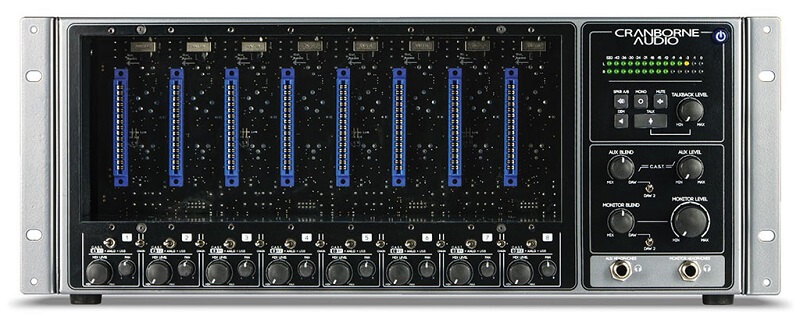
- Monitor controller
- 8 Channel discrete analogue summing mixer
- Reference AD/DA converter
- Latency-free monitor mixer with volume and pan controls per channel
- 2 Monitor outputs: Speaker A outs & Speaker B outs
| For EU Customers | |||
|---|---|---|---|
Cranborne Audio 500R8 |
|
3. IGS Audio Panzer 500
The Panzer 500 chassis is just as no-nonsense as you’d expect. This metal enclosure is a rackmount design, holding a circuit board with EDAC connectors that can accommodate up to 10 modules—impressive for just 3U of standard 19-inch rack space.
On the far right, there’s a one-module-wide panel that hosts a few LEDs to indicate the presence (or absence) of power on the ±16V rails and the +48V phantom supply. Power is delivered through a compact yet rugged external unit with its own carry handle, offering an average of 420mA per module slot.
This power supply connects securely to the chassis via a cable with chunky, screw-threaded metal connectors, which is a nice touch. The IEC cable plugs into one end, the chassis power cable comes out the other, and a robust-feeling toggle switch lets you power everything up easily.
Audio I/O is handled on the rear panel, with 10 individual XLR inputs and another 10 XLR outputs, all clearly labeled with pin hot/cold wiring. It really couldn’t be simpler, and in our tests, it worked flawlessly with the IGS modules and every other module we tried.
All in all, this is a solid modular system for the money, and the fact that IGS seems to be expanding the range can only be a good thing. For us, though, the real star is the Panzer 500 chassis and its power supply, which give you a generous amount of 500-series real estate for your investment and make it easy to combine 500-series and standard 19-inch rackmount gear in a smart, practical way.
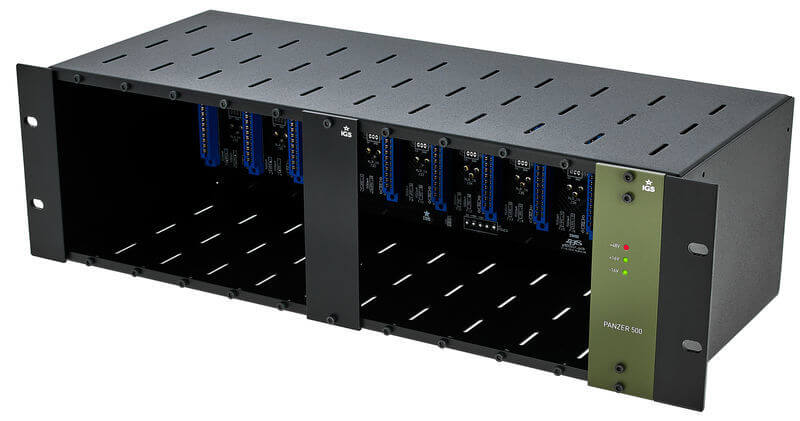
- Predominantly use stepped switch controls.
- Up to 10 processors in a 3U rack space.
- New modules being added to the range.
- Large LED meters.
| For EU Customers | |||
|---|---|---|---|
IGS Audio Panzer 500 |
|
4. Heritage Audio OST-4 V2
House all your prized 500 Series gear in the Heritage Audio OS-4 v2.0 Chassis—a premium 500 Series rack with four slots. This high-quality enclosure accommodates double-wide modules, as well as demanding Class-A and vacuum tube designs. Thanks to Heritage Audio’s On Slot Technology, the OS-4 v2.0 ensures each channel enjoys top-notch safety, isolation, and filtering.
Each slot provides 400mA of current, for a total of 1.6A, and up to 140mA of phantom power is available. Every slot essentially has its own individually regulated and isolated power supply. This means no power-hungry module can affect the performance or fidelity of your other gear.
Heritage Audio also assures that many 500 Series modules will actually perform better in the OS-4 v2.0. For example, you should notice—and be able to measure—a lower level of self-noise in your 500 Series preamps.
On the rear panel, you’ll find four XLR inputs and four XLR outputs, along with a five-pin XLR power input jack. All XLR connectors are gold-plated. A major upgrade in this rack is the link feature, which automatically feeds one channel into the next at the push of a button. Now, you don’t need patch cables to send signals in series—just press the link button between two slots, and one will feed directly into the other.
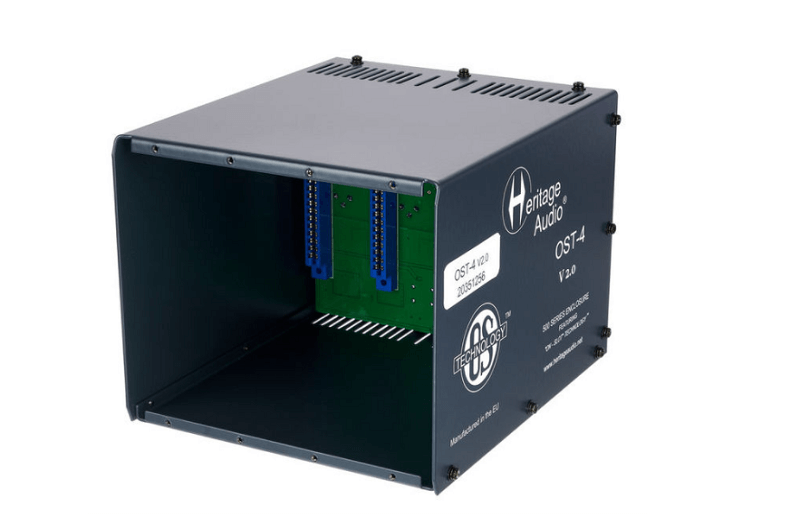
- Power supply with 400 mA per rack
- Phantom power supply (140 mA max. total demand)
- External power supply unit
- XLR connections
| For US Customers | For EU Customers | |||
|---|---|---|---|---|
Heritage Audio OST-4 V2 |
5. API Audio 500-8P Lunchbox
From the inventors of the 500-series format, the API 500-8B Lunchbox is an 8-slot, 500-series powered rack designed to accept all API standard 5.25″ x 1.5″ modules. This allows you to configure a recording or mixing setup tailored to your specific needs.
The API 500-8B Lunchbox is the big brother to the API 500-6B, featuring a universal power supply with a rear-panel AC voltage selector switch and a detachable power cord. Input and output connections are made through DB-25 (D-Sub) connectors for convenient I/O. The 500-8B Lunchbox comes standard with a +48 volt internal phantom power supply, bussed to pin 15 for seamless integration with the API 512c Mic Preamplifier.
Older 560A equalizers may use pin 15 as a “direct output” and require modification on the 560A circuit board edge connector by cutting a trace. This eliminates the risk of 48 volts damaging the 560A series equalizers.
On the rear panel, the 500-8B Lunchbox provides two 8-channel connectors for input and output, along with a power connector and AC power selector switch for use worldwide.
The Lunchbox gives engineers the flexibility to bring specialized EQ effects to any session, such as the 550A, 550b, or 560. The Lunchbox is self-powered. API offers a variety of modules for the 500 series, including the 512c Mic Preamplifier, 525 Compressor, 527 Compressor, 550A 3-band EQ, 550b 4-band EQ, and 560 Graphic EQ. Combinations of these modules make excellent stereo recording packages (two 512Cs and two 550Cs) or dedicated setups for vocalists (one 512c, two EQs, and one 527).
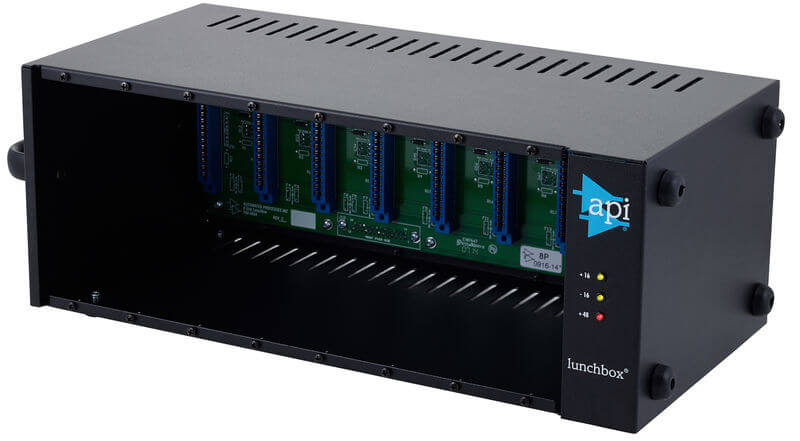
- Integrated power supply from 100 – 250 Volt switchable
- Rugged steel housing
- Rubber feet and carrying handle
- 19″ Rack kit optional (not included, available under Art.
| For EU Customers | |||
|---|---|---|---|
API Audio 500-8P Lunchbox |
|
6. Fredenstein Bento 8 Pure Analog
Like most 500-series chassis, the Bento 8 is a 3-rack space unit and comes with both feet for desktop use and rack ears. We appreciate this, since it means you don’t have to buy them separately if you decide to mount it in a rack. All the inputs and outputs use XLR connections.
This setup works well, but some users might prefer a chassis with DB25 and/or 1/4-inch TRS connectivity. There’s a power switch, which is convenient, but it’s located on the back—so it might be hard to reach in a rack. One very useful feature is the built-in linear power supply, which means you can plug it in with a standard IEC cable—no external power supplies to lose in the tangle of cables behind your rack.
Even preamps plugged in right next to the power supply were completely noise-free, thanks to what Fredenstein describes as “in-depth magnetic shielding” around the mains transformer. If that’s not enough, the Bento 8 also includes a ground-lift switch, though the manual wisely suggests using this only if absolutely necessary.
The specs promise 500 mA per slot, which is more than enough to power everything. We were also happy to see that this unit is sturdy and well-built. It’s heavier than we expected, feels solid throughout, and features countersunk fasteners so you won’t scratch up your other rack gear.

- Compressor link and ground lift switch
- Intelligent voltage distribution
- Energy efficient
- Design: 19″ / 3U
| For US Customers | For EU Customers | |||
|---|---|---|---|---|
Fredenstein Bento 8 Pure Analog |
7. Radial Engineering Workhorse SixPack
Let’s start with the back panel. As you’d expect, there are XLR jacks for six channels of input and output. If you want to use the SixPack like a standard 500-series chassis, just connect your cables to the XLRs, plug in the external power supply, and you’re good to go. But if you stop there, you’ll be missing out on all the real fun!
Between every pair of odd and even slots on the back, you’ll find Link switches. These allow you to “link” adjacent modules that support stereo linking, without having to mess with internal jumpers or solder anything on the SixPack’s backplane.
You’ll also find Feed switches between each slot. These make it easy to connect the output of one module directly to the input of the next, without using extra patch cables. This lets you quickly chain several modules together into a “channel strip.” For example, you can “feed” a mic preamp in slot 1 into an EQ in slot 2, then into a compressor in slot 3, just by flipping the right Feed switches.
The input for your channel strip would be the input of slot 1, and the output would be the output of slot 3. If you want to record the signal before compression as well (for parallel processing or backup), you can simply take the output from slot 2 and patch it into your recorder. These Link and Feed switches are signature features of the entire Radial Engineering Workhorse line.
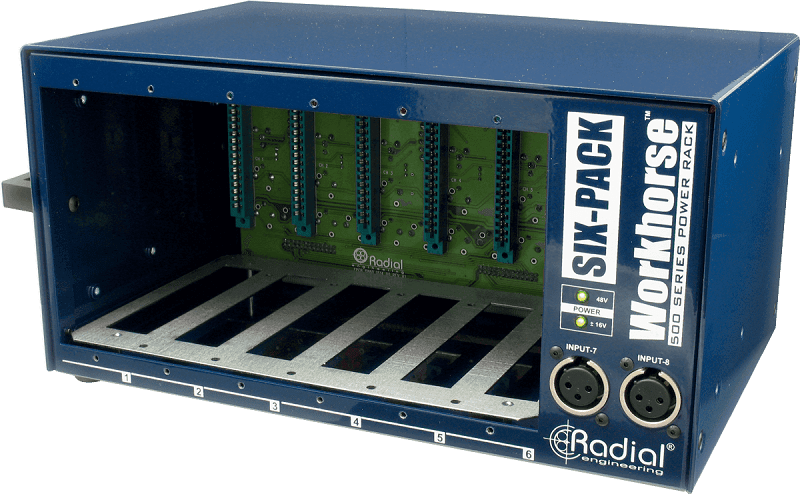
- For system 500 modules
- Per input channel input (XLR and jack), output (XLR and jack)
- Switchable 48 V phantom power
| For US Customers | For EU Customers | |||
|---|---|---|---|---|
Radial Engineering Workhorse SixPack |
8. Midas Legend L10
The Legend L10 500 Series Rackmount Chassis lets you mix and match a wide range of audio processing modules to build the perfect signal chain for any application. With space for up to 10 single-width modules, advanced audio routing for simple cabling, and a robust auto-ranging switch-mode power supply, you can take your favorite modules anywhere with complete confidence.
Designed to work with all 500 series-compatible modules and plug-in cards, the L10 is the ideal partner for your Microphone Preamplifier 502, Compressor Limiter 522, Parametric Equalizer 512, and the many other modules currently in development—as well as those from third-party manufacturers.
Whether you’re in the studio or on the road, complicated signal chain cabling is no longer a problem. The L10’s audio output link switches make it easy to rearrange and connect your modules without complicated cables. Just install your modules in the order you want, and pass the signal along the chain—no extra cables needed. This not only keeps your rack tidy, but also preserves ultimate signal integrity.
Thanks to the onboard ground lift switch, you can easily lift the audio ground and eliminate annoying ground loop issues that could otherwise ruin a perfect performance.
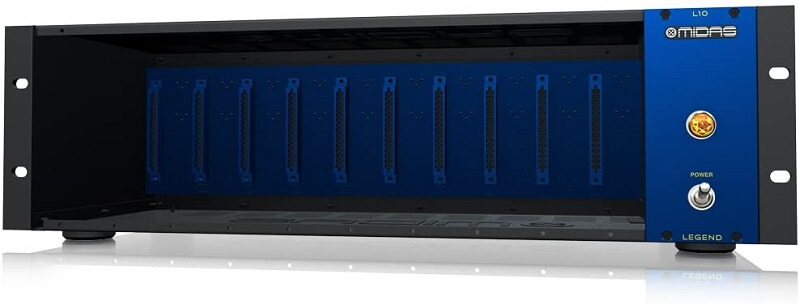
- Width: 448.31 mm
- Height (without feet): 132.40 mm
- Height (with feet): 139.50 mm
- Depth: 210.63 mm
| For US Customers | For EU Customers | |||
|---|---|---|---|---|
Midas Legend L10 |
9. Lindell Audio 510 Power MKII
We recommend the Lindell Audio 510 Power MkII ten-slot chassis and power supply to anyone looking for a rackmount 500-series frame. It offers several features that make it both useful and versatile.
First, it includes both XLR and DB25 connectors (wired in parallel) for the first eight slots. This makes it much easier and more cost-effective to connect to a patch bay with DB25 connectors. We really appreciate this feature because it makes the rack simple to interface with most multichannel converters, especially if you’re doing remote recording—which is one of our main uses for 500-series gear.
Second, it has feed switches between slots. For example, you can link the output of a mic preamp in slot 1 directly to the input of an EQ in slot 2 without using any cables. This is another great feature for remote recording, as it lets you build channel strips within the rack itself.
Third, unlike most other 500-series frames, this one has a sturdy, metal-boxed external power supply instead of a bulky line lump that often fails when its cables are under too much strain—something that happens frequently on remote gigs.
The Lindell comes with a standard IEC input jack for AC power (100–250 V, 50/60 Hz) and an XLR5 output for DC power to the chassis. As a result, every cable can be disconnected from the power supply and easily replaced if there is ever a failure. The power supply delivers up to 5 A, and if your modules together draw too much current, a safety circuit will shut the power supply down to protect your gear.
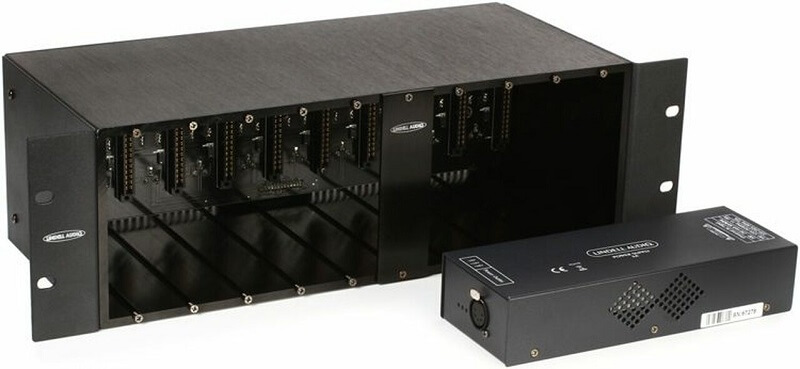
- External universal power supply unit 100-250 V
- Short circuit and overload protection
- Light aluminium housing
- Includes 19″ rack adapter and blanking plate
| For EU Customers | <th class="nichetable__th" data-th="For US||||
|---|---|---|---|---|
Lindell Audio 510 Power MKII |
10. Black Lion Audio PBR-8 500
The folks at Black Lion Audio had an idea that really sets their new Patchbay Rack 8 (PBR-8) apart from most, if not all, other 500 Series enclosures: they’ve built a TT patch bay for all eight channels’ inputs and outputs right into the front panel of the chassis, and they’ve also included two sets of mults (one in, two outs).
Black Lion teamed up with Heritage Audio in Spain to build the PBR-8, taking advantage of Heritage’s OST (On Slot Technology), which provides power regulation for each slot to reduce noise and crosstalk. On the back panel, each channel has an XLR input and output, but there are also DB-25 jacks so you can wire all eight channels with a single cable—super handy if you’re connecting to a patch bay with DB-25 connectors. An external, “lump-in-the-middle” style power supply feeds the PBR-8 through a locking multi-pin connector.
Imagine you’re heading to another studio and want to bring some of your own gear to hook up to their equipment. In the PBR-8, for example, you could fill six slots with a pair of preamps, a pair of EQs, and a pair of compressors (essentially a couple of channel strips), and then put a stereo bus compressor in the final two slots.
Now, picture being able to change the order of the channels—whether you want EQ before compression or after, or even route the outputs of your channel strips into the bus compressor—without reaching behind the rack, moving cables around, chaining outputs to inputs, or dealing with the studio’s own patch bay. With the PBR-8, all of this is easily done from the front panel, making these scenarios quick and hassle-free.

- Integrated balanced TT / Bantam Patchbay
- 2 Multiples / Signal splitter
- ‘On Slot Technology’ by Heritage Audio
- Up to 400 mA available per slot
- Solid steel housing
| For US Customers | For EU Customers | |||
|---|---|---|---|---|
Black Lion Audio PBR-8 500 |
Conclusion
We believe that any of these ten 500 series chassis will get the job done and serve you well. You shouldn’t run into any problems with any of them. To help you choose, we’ve included a short review for each one so you can decide which suits your needs best.
Our selection wasn’t based on the number of slots, but rather on functionality and popularity. You’ll find options ranging from 2 or 3 slots all the way up to 10 slots—or possibly even more.
If you think we’ve missed something important in this article, please let us know in the comments section. We’ll be happy to respond and update the content!

